FEATURE ARTICLE 3: CHANGING WATER AND ENERGY USE IN PERTH HOMES
INTRODUCTION
Domestic water and energy use has been the focus of much attention in recent times, particularly among the media, public interest groups and government. Concerns have heightened over Perth's available water supply and the use of high energy consuming appliances. With the economy growing rapidly, Western Australia's population and housing requirements have increased substantially, placing considerable pressure on the state's water and energy resources. As a result, the Western Australian Government has implemented strategies, such as rebate schemes and education campaigns, to help reduce the excessive use of water and energy in Perth homes. For government to assess the effectiveness of these strategies, timely and accurate data on domestic water and energy use are urgently required.
A survey of Domestic Use of Water and Energy in Western Australia was recently conducted by the ABS, based on topics proposed by the Water Corporation and Office of Energy. This supplementary survey program is an ABS initiative to develop and run a household survey each year on behalf of State Government. This program provides State Government with the opportunity to survey Western Australian households about emerging topics or issues that are of high priority to the state, particularly when existing data is limited or out-of-date.
This article analyses data from the Survey of Domestic Use of Water and Energy, Western Australia, October 2006 (cat. no. 4652.5) and compares the results with those from past ABS surveys on water and energy use. It examines whether water and energy using behaviours and perceptions have changed over time in Perth homes.
WATER USE IN PERTH HOMES
Western Australia is currently facing significant challenges in meeting its growing water needs, with low rainfall in recent years compromising current water reserves. With 24% of the state's water consumed by Western Australian households in 2004-05 (ABS, 2006 cat. no. 4610.0) and the demand for water in Perth homes increasing substantially in the last 15 years (following a 34% rise in the number of households from 449,000 in 1992 to 603,300 in 2006), water conservation has become a top priority for the Water Corporation and environmental groups. The Government of Western Australia introduced a rebate scheme for the purchase of water-saving appliances, as well as restrictions on watering gardens from town water supplies. The Water Corporation has also put in place an extensive 'Waterwise' programme to educate households about the importance of saving water in the garden and home.
ADDITIONAL WATER SOURCES
Nearly all (98%) of Perth households are connected to mains or town water supply. However, additional water sources are also available, such as rain and bore water. Approximately 5% of Perth homes used water from a rain water tank in 2006, a proportion unchanged since 2003 (5%). Over half (52%) of the households with rain water tanks used the water for drinking and a slightly higher proportion (55%) used it on the garden. Anecdotally, the installation of rain water tanks, primarily to water the garden, may become more popular in Perth as cheaper DIY installation units become available, and householders take advantage of rebate schemes. Across the capital cities, domestic use of water from rain water tanks ranged from 5% (4.8%) in Brisbane to 38% in Adelaide, with 9% of all homes in Australian capital cities using this source of water (ABS, 2004 cat. no. 4602.0).
In 2006, bore water was used by one-quarter of Perth households (26%), a proportion that has risen slightly since 2003 (24%) and 1992 (22%). However, the number of households that use bore water has risen from 99,600 in 1992 to 150,900 in 2006. Concerns about bore water use in Perth have been raised recently in relation to its possible impact on ground water levels. Currently bore water users do not have restrictions on the number of days per week they can water their gardens. Only their hours of usage are restricted (from 6pm to 9am each day).
WATER EFFICIENCY
A number of water saving devices have been introduced over the last few decades, which have been taken up in Perth homes with varying degrees of success. Dual flush toilets, an Australian invention, were introduced in the early 1980s. In 1993, it became compulsory in Western Australia for all newly built homes to have dual flush toilets installed (Department of Housing and Works, 2006). Despite 64% of Perth homes being built before 1992, most householders have been keen to convert or replace their single flush toilets. In 2006, 84% of all Perth households had dual flush toilets, compared to only 36% in 1992.
PROPORTION OF HOUSEHOLDS WITH DUAL FLUSH TOILETS, Perth
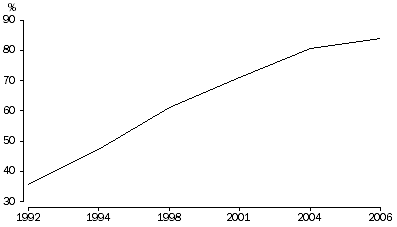
Even though water efficient shower heads, or low flow shower heads, are not a building requirement, they are included under the 'Waterwise' rebate scheme and their use has been increasing since 1992. In 2006, 51% of all Perth homes had water efficient shower heads installed, compared to 21% in 1992.
PROPORTION OF HOUSEHOLDS WITH WATER EFFICIENT SHOWER HEADS, Perth
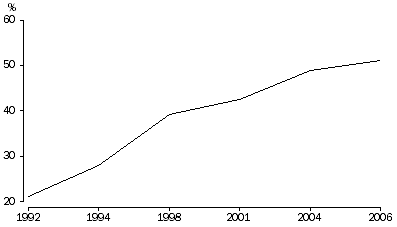
Washing machines are major consumers of water in Perth homes, especially in larger households. Front loading washing machines greatly reduce water usage and are included under the 'Waterwise' rebate scheme. In 2006, one-quarter of Perth households used a front loading washing machine, a proportion which has almost doubled since 2003 (14%) and more than tripled since 1992 (7%).
In 2006, front loading washing machines were more popular in large households, with almost one-third (29%) of households comprising three or more persons using this type of appliance. The comparable proportion in 2003 was 16%.
PROPORTION OF HOUSEHOLDS WITH FRONT LOADING WASHING MACHINES, By household size, Perth
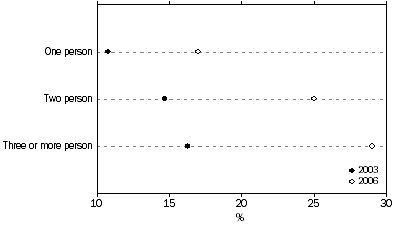
In Perth, the proportion of households with dishwashers has more than doubled between 1992 (18%) and 2006 (38%). Some newer dishwashers are very water efficient and can use less water than if dishes are cleaned by hand. However, it is likely that the increased use of dishwashers has led to increased water use in Perth homes, though this increase may have been substantially offset by the greater usage of dual flush toilets and water efficient shower heads (Loh and Coglan 2003). In 2005, Perth recorded the equal lowest dishwasher use among the capital cities, with an estimated 37% of all Perth homes using a dishwasher, compared to 44% of all Australian capital cities (ABS, 2005 cat. no. 4602.0).
WATER CONSERVATION IN THE GARDEN
Garden water use accounts for around half of annual domestic water consumption in Perth (Water Corporation website). Introducing water conservation practices in the garden can, therefore, dramatically reduce the amount of water being taken from mains or town water supply. Apart from using alternative water sources, such as rain water tanks, applying mulch in the garden and reusing or recycling household water for use in the garden are two popular conservation practices.
In 2006, an estimated 70% of Perth households living in detached dwellings used mulch in their gardens - virtually unchanged since 2003 (69%). Of these households, 37% reused water in the garden, a proportion which has decreased from 2003 (44%). Despite the promotion of grey water use in the garden by the Water Corporation and Local Government, the initial installation costs, coupled with publicised health risks, may have deterred a number of households. Grey water, defined as water from washing machines, showers and the laundry tub, can either be diverted for use in the garden or be processed by a treatment system. The diversion of grey water without treatment can only be applied to the garden via sub-surface irrigation and cannot be stored. Negative publicity about the use of grey water has focussed on disease-causing organisms, which should not be used on vegetable gardens.
Swimming pools and outdoor spas have been recognised as contributing to increased domestic water consumption, with 20% of Perth households having a swimming pool or outdoor spa in 2006. The use of pool and spa covers can dramatically reduce the amount of water wasted through evaporation. Almost one-third (32%) of Perth households with a swimming pool and 90% of those with an outdoor spa used a cover during the warmer months. The majority of households using a pool cover during the warmer months reported using it always (70%), while 14% used it sometimes and 10% never used it.
ENERGY USE IN PERTH HOMES
According to recent Australian Bureau of Agricultural and Resource Economics (ABARE) reports, Western Australia's consumption of energy between 1989-90 and 2004-05 rose approximately 4%, the highest across Australia (ABARE 2006). This increase was the result of the state's population and economic growth, including the expansion of mining and other energy intensive industries in the state. This growth has created a housing boom, with the effects still evident in high property prices and building industry pressures. All of these factors have contributed to increased domestic energy use, which is predicted to continue rising over the next couple of decades (Akmal and Riwoe, 2005).
COOLING
In 1992, 40% of Perth homes used air conditioners. By 2006, this proportion had almost doubled to 74%, with the number of air conditioners more than doubling over the same period (177,800 in 1992 to 447,300 in 2006). The increased use of air conditioners to cool Perth homes has been the driver of various education campaigns (such as Synergy's "Beat the Peak" between 3pm and 6pm), which highlight the high energy use of these appliances.
Apart from the large increase in the number of air conditioners, the type of air conditioning has also changed. In 2006, half of Perth homes with air conditioning reported that their main cooling unit was a reverse cycle air conditioner. The corresponding proportion in 1992 was 37%. The domestic use of evaporative air conditioning has also increased, from 26% in 1992 to 36% in 2006. Usage of both types of air conditioner has increased at the expense of refrigerated air conditioning, which accounted for 35% in 1992, but was down to 14% in 2006.
PROPORTION OF HOUSEHOLDS USING AIR CONDITIONING, By type of air conditioner used, Perth
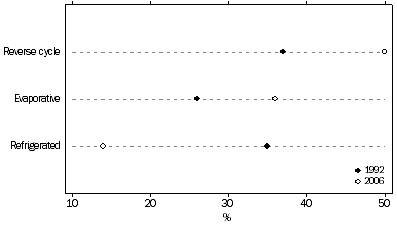
The popularity of these air conditioner types appear to have been accompanied by changes to the positioning or location of the unit within the home. In 2006, 33% of Perth homes had an evaporative ducted air conditioner and 24% used reverse cycle split systems. Despite no historical data being available for comparison, anecdotal evidence suggests there has been an increase in the use of split systems and ducted air conditioners, at the expense of older style cooling units set in walls or windows.
HEATING
Home heating appliances consume large amounts of energy. In 2006, 89% or 536,500 Perth households reported using heaters, with the majority of these using one heater in their homes (69%). The proportion of Perth homes using heaters has not changed significantly over the last few years, however, the type of heaters used have changed. Gas heaters are the most popular type of domestic heating used in Perth (52% of households in 1999 and 2006) (ABS, 2004, cat. no. 4602.0).
The use of wood heaters has dropped significantly in recent years. Between 1999 and 2006, the use of wood heating in Perth homes more than halved from 22% to 9%, a decline which coincided with State Government initiatives to improve air quality by reducing the amount of wood fire haze (linked to increases in respiratory problems and asthma hospitalisation) (Department of Environment, 2006). The Western Australian Department of Environment conducted the Perth Heating Survey in 2004, to assess the behaviours and perceptions of householders with regard to wood heating. The survey found that, even though householders were aware of wood fires contributing to poor air quality, they rated Perth’s air quality as good or very good, highlighting the need for State Government to encourage householders to switch to alternative sources of heating.
Changes in heating type may also reflect the increased popularity of reverse cycle air conditioners. In 1999, one in 20 Perth homes (5%) used reverse cycle air conditioners as their main heater. By 2006, one in five (22%) Perth homes used reverse cycle air conditioning as their main form of heating, second only to gas heating. This certainly supports anecdotal information that the relatively low purchase price of reverse cycle air conditioners, particularly split systems, has resulted in their increased popularity in Perth homes.
PROPORTION OF HOUSEHOLDS USING WOOD HEATING AND REVERSE CYCLE AIR CONDITIONING, Perth
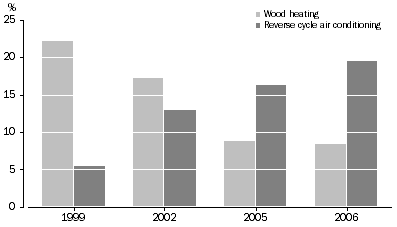
WATER HEATING
In 2006, 390,700 (65%) Perth homes had mains gas water heating. Of these, half (50%) were storage systems and half (48%) were instantaneous systems. Electricity was the second most popular source for water heating (21%), with more than half using a storage tank system (56%) and 14% using solar hot water systems. Gas water heating appliances have remained the most popular since 1992, when an estimated 45% of Perth households used this type of appliance. In 1992, however, both electric and solar hot water systems were more popular than they are today (28% and 24% respectively).
Solar hot water heaters have been used in Australian homes for a couple of decades. Besides reducing the cost of heating water by up to 75%, solar hot water systems reduce a home's contribution to greenhouse gas emissions. The Western Australian Sustainable Energy Development Office offers a rebate subsidy to home owners who install solar hot water systems, as the initial cost of these units can be up to five times higher than for other types of water heating appliance. Despite having reduced its use since 1992, Perth still has a much higher proportion of homes using solar hot water than the Australian average (5% in 2006) (ABS, 2005 cat. no. 4602.0).
PROPORTION OF HOUSEHOLDS WITH WATER HEATING, By type of water heater used, Perth
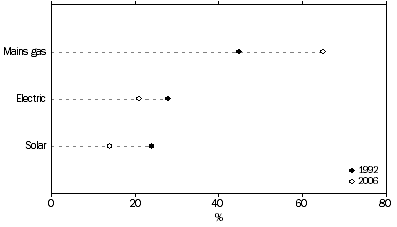
SUMMARY OF FINDINGS
Domestic water and energy use has become an area of particular focus for the Western Australian Government, as the state's water and energy resources have come under increased pressure from a rapidly expanding economy and population. This analysis has shown that, over the last fifteen years, Perth households have embraced a number of new technologies, including appliances that have reduced water use in their homes. However, the increased reliance on high energy using devices, such as air conditioners, has placed added pressure on the energy supply in the state.
REFERENCES
- ABARE, 2006 Australian Energy Consumption and Production, 1974-75 to 2004-05. Canberra.
- Akmal, M. and Riwoe, D. 2005, Australian Energy: National and State Projections to 2029-30, ABARE eReport 05.9, Prepared for the Australian Government Department of Industry, Tourism and Resources, Canberra.
- Australian Bureau of Statistics, 2007 Domestic Use of Water and Energy, Western Australia, October 2006. cat. no. 4652.5, Perth.
- Australian Bureau of Statistics, 2006 Water Accounts, Australia, 2004-05. cat. no. 4610.0, Canberra.
- Australian Bureau of Statistics, 2005 Environmental Issues: People’s Views and Practices, March 2005. cat. no. 4602.0, Canberra
- Australian Bureau of Statistics, 2004 Domestic Water Use, Western Australia, October 2003. cat. no. 4616.5.55.001, Perth.
- Australian Bureau of Statistics, 2004 Environmental Issues: People’s Views and Practices, March 2004. cat. no. 4602.0, Canberra.
- Australian Bureau of Statistics, 2002 Energy efficiency in the home, Australian Social Trends, pp. 203-207. cat. no. 4102.0, Canberra.
- Australian Bureau of Statistics, 1994 Conservation of Energy, Water and the Environment, Perth Statistical Division, November 1992. cat. no. 4650.5, Perth.
- Department of Environment, 2006 Perth Home Heating Survey 2004: Technical Report. Government of Western Australia, Perth.
- Department of Housing and Works, 2006 Housing Strategy Western Australia, Section 7 sustainability of current and future housing, pp. 96-106. Government of Western Australia, Perth.
- Loh, M and Coghlan, P., 2003 Domestic Water Use Study: In Perth, Western Australia 1998-2001. Water Corporation, Perth.
 Print Page
Print Page
 Print All
Print All